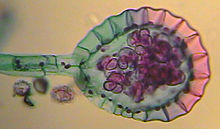spore


In biology, a spore is a mostly unicellular, rarely also a few-celled developmental stage of living beings that serves asexual reproduction , spread, persistence or several of these purposes at the same time and is not a gamete (not a sex cell ).
Occurrences and variants
Spores are formed by fungi , algae , mosses and ferns, as well as some protozoa and bacteria . In the case of the seed plants , the pollen mother cell and the embryo sac mother cell are regarded as spores, although they remain in the mother plant; they are homologous to the spores of vascular pore plants (mosses and ferns) .
Spores are differentiated according to the type of their formation ( sporulation ): Depending on whether they arise after a meiosis or after a mitosis , a distinction is made between meiospores and mitospores. In Diplohaplonts ( Embryophyta and most algae) a further distinction can be made according to whether they are formed by the gametophytic or the sporophytic generation. Meiospores and mitospores formed by the gametophytic generation are usually haploid , whereas mitospores formed by the sporophytic generation are regularly diploid .
properties
The spores are often formed in large numbers, which means that they primarily serve to multiply and spread. If the spore formation is triggered by adverse environmental conditions and the spores are resistant to them, they serve to withstand these adversities. Many spores are extremely resistant, for example, they can stop their entire metabolism and then need neither water , nutrients nor oxygen . In addition, they often have cell walls that prevent water from evaporating. Because of this, they can often survive for a very long time and under very inhospitable conditions.
Because of their resistance to biological decay and the large number in which they are released, spores are often found in fossil and historical deposits. In archeology and palaeontology they serve as indicators for dating , environmental conditions and climate changes .
There are ideas according to which gametes (small, haploid developmental stages of living beings, formed for sexual reproduction) developed from spores in the course of the evolution of organisms.
Endospores of bacteria are of particular importance because they are usually very resistant to dehydration, toxic and otherwise aggressive substances, aging and heat. For example, some bacterial endospores can survive for a few hours in boiling water and for about an hour at 150 ° C when dry.
It is believed that bacterial endospores could survive for several hundred, maybe even a thousand years and defy the harsh radiation in space and thus - as presented in the panspermia hypothesis - could have mastered space travel long before mankind.
See also
literature
- Lexicon of biology : spores . Spectrum, Heidelberg 1999.
- Meyers Lexikonredaktion (Hrsg.): Meyers Taschenlexikon Biologie. 2nd Edition. BI-Taschenbuchverlag, Mannheim, Vienna, Zurich 1988, ISBN 3-411-02970-6 , Vol. 3, p. 153.
- Friedrich W. Stöcker, Gerhard Dietrich: Brockhaus abc - Biology. 7th edition. VEB FA Brockhaus Verlag, Leipzig 1986, ISBN 3-325-00071-1 , Vol. 2, p. 836.
- Georg Fuchs (ed.): General microbiology. 8th edition. Thieme, Stuttgart, New York 2007, ISBN 978-3-13-444608-1 , pp. 146-148 (spores of prokaryotes).

